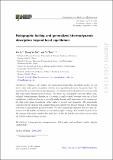Holographic boiling and generalized thermodynamic description beyond local equilibrium
Author(s)
Li, Xin; Nie, Zhang-Yu; Tian, Yu
Download13130_2020_Article_13764.pdf (1.418Mb)
Publisher with Creative Commons License
Publisher with Creative Commons License
Creative Commons Attribution
Terms of use
Metadata
Show full item recordAbstract
Abstract
Tuning a very simple two-component holographic superfluid model, we can have a first order phase transition between two superfluid phases in the probe limit. In- spired by the potential landscape discussion, an intuitive physical picture for systems with first order phase transitions is provided. We stress that holography perfectly offers a generalized thermodynamic description of certain strongly coupled systems even out of local equilibrium, which enables us to carefully study domain wall structures of the system under first order phase transitions, either static or in real time dynamics. We numerically construct the 1D domain wall configuration and compute the surface tension of the domain wall from its generalized grand potential. We also numerically simulate the real time dynamics of a 2D bubble nucleation process (holographic boiling). The surface tension of the 1D domain wall nicely matches the final state of the 2D bubble nucleation process when the bubble radius is large enough.
Date issued
2020-09Department
Massachusetts Institute of Technology. Center for Theoretical PhysicsJournal
Journal of High Energy Physics
Publisher
Springer Berlin Heidelberg
Citation
Journal of High Energy Physics. 2020 Sep 08;2020(9):63
Version: Final published version
ISSN
1029-8479